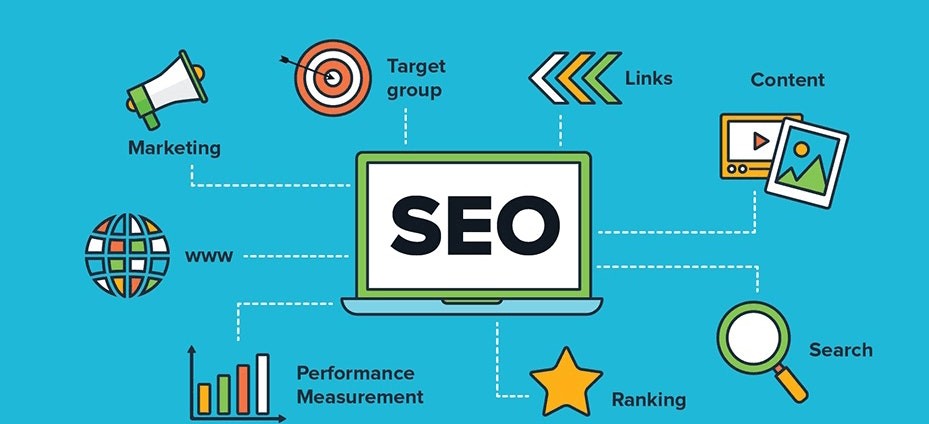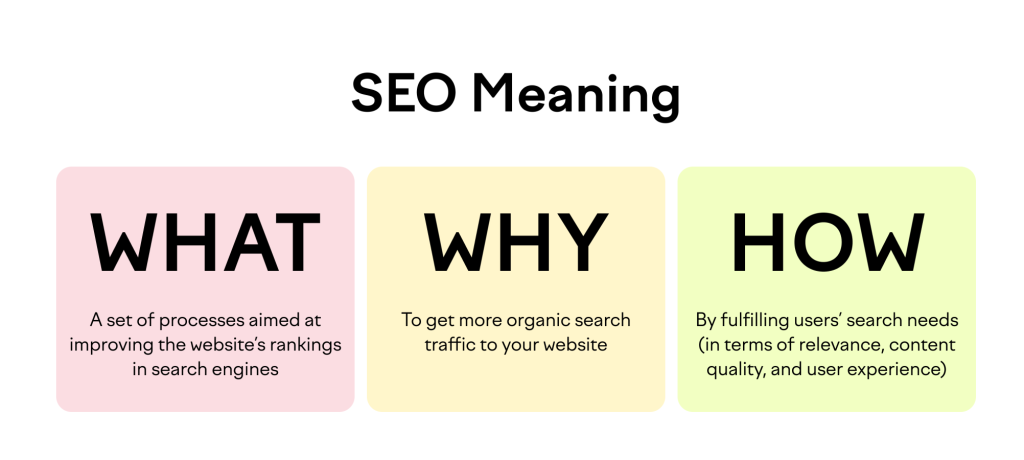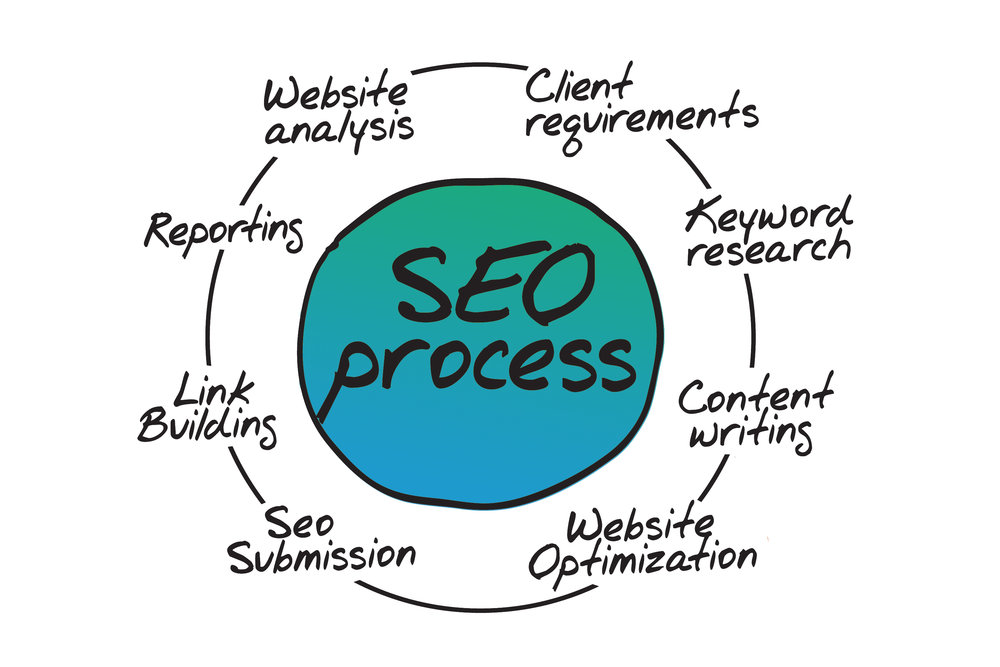What is Search Engine Optimization
Search Engine Optimization (SEO) refers to the practice of optimizing a website and its content to improve its visibility and ranking on search engine results pages (SERPs). The goal of SEO is to increase organic (non-paid) traffic to a website by making it more relevant and authoritative in the eyes of search engines.
SEO involves various techniques and strategies that focus on both on-page and off-page elements of a website. On-page SEO includes optimizing the website’s structure, content, keywords, meta tags, and HTML code to make it more search engine-friendly. Off-page SEO involves building high-quality backlinks from other reputable websites, social media engagement, and other external factors that influence search engine rankings.
The primary purpose of SEO is to ensure that a website appears prominently in relevant search results when users search for specific keywords or phrases. By ranking higher in search engine results, websites have a better chance of attracting organic traffic, increasing visibility, and reaching their target audience.
SEO is an ongoing process that requires continuous monitoring, analysis, and optimization to adapt to changing search engine algorithms and user behavior. It requires a combination of technical expertise, keyword research, content creation, link building, and other optimization strategies to achieve long-term success in driving organic traffic to a website.


Why is SEO important?
- Increased Organic Traffic: SEO helps to improve a website’s visibility in search engine results, leading to increased organic (non-paid) traffic. By optimizing a website’s content and structure, it becomes more likely to appear in relevant search queries, attracting users who are actively searching for information, products, or services related to the website’s offerings.
- Higher Search Engine Rankings: SEO aims to improve a website’s ranking on search engine results pages (SERPs). Websites that appear higher in the search results are perceived as more trustworthy and authoritative by users. Higher rankings also increase the chances of users clicking on the website’s link, resulting in more traffic.
- Enhanced User Experience: SEO involves optimizing various aspects of a website, such as its loading speed, mobile responsiveness, user-friendly navigation, and quality of content. These optimizations improve the overall user experience, making it easier for visitors to navigate the site, find the information they need, and engage with the content. A positive user experience leads to longer visit durations, lower bounce rates, and increased chances of conversions.
- Targeted Audience Reach: SEO allows businesses to target specific keywords, phrases, and demographics relevant to their products or services. By appearing in search results for these targeted queries, businesses can reach their ideal audience. This targeted reach increases the likelihood of attracting qualified leads and potential customers who are more likely to convert.
- Cost-Effective Marketing: SEO is a cost-effective marketing strategy compared to other digital advertising methods. While it requires an investment of time and effort, the long-term benefits of improved organic rankings can provide a consistent stream of free, high-quality traffic. This can significantly reduce the need for paid advertising, resulting in cost savings for businesses.
- Competitive Advantage: In today’s digital landscape, most businesses have an online presence, and competition is fierce. Implementing SEO strategies helps businesses stand out from their competitors by improving their visibility, ranking, and overall online presence. By staying ahead of competitors in search engine rankings, businesses can attract more customers and establish themselves as industry leaders.
Overall, SEO is essential for businesses looking to maximize their online visibility, attract targeted traffic, and achieve long-term success in the digital landscape. It helps businesses build brand awareness, generate leads, increase conversions, and stay ahead of the competition.
Types of SEO
There are three main types of SEO:
- On-Page SEO: On-page SEO focuses on optimizing individual web pages to improve their search engine rankings and attract organic traffic. It involves optimizing various elements within the website, including content, HTML source code, meta tags, headings, URL structure, keyword usage, internal linking, and user experience factors such as page load speed and mobile responsiveness. On-page SEO ensures that a website is structured, formatted, and presented in a way that search engines can understand and rank it effectively.
- Off-Page SEO: Off-page SEO refers to activities performed outside of the website to improve its search engine rankings and authority. It primarily involves building high-quality backlinks from other reputable websites to signal to search engines that the website is trustworthy and relevant. Off-page SEO also includes social media marketing, influencer outreach, online reputation management, guest blogging, and brand mentions. These activities help to increase the website’s visibility, credibility, and popularity across the web.
- Technical SEO: Technical SEO focuses on optimizing the technical aspects of a website to improve its search engine visibility and crawling efficiency. It involves optimizing factors such as website speed, mobile-friendliness, site architecture, URL structure, XML sitemaps, robots.txt file, canonicalization, schema markup, SSL certificate, and ensuring proper indexing of web pages by search engines. Technical SEO ensures that a website is technically sound and meets the requirements of search engines, making it easier for them to crawl, index, and rank the website.
How does SEO work?
SEO, or Search Engine Optimization, is the practice of optimizing a website to improve its visibility and rankings on search engine results pages (SERPs). Here’s how SEO works:
- Crawling: Search engines like Google use automated software called crawlers or spiders to browse the web and discover web pages. These crawlers follow links from one page to another, collecting information about the content and structure of each page they encounter.
- Indexing: Once a page is crawled, the search engine adds it to its index, which is a massive database of web pages. The index stores information about the content, keywords, and other relevant data of each page.
- Ranking: When a user performs a search query, the search engine analyzes its index and tries to match the query with the most relevant web pages. The search engine’s algorithm considers numerous factors to determine the ranking of web pages, including relevance, authority, user experience, and more.
- On-Page Optimization: To improve the chances of a web page ranking higher, on-page optimization techniques are employed. This involves optimizing elements such as title tags, meta descriptions, headings, URL structure, keyword usage, content quality, and user experience factors like page load speed and mobile responsiveness.
- Off-Page Optimization: Off-page optimization involves activities outside the website that can improve its rankings. This primarily focuses on building high-quality backlinks from other reputable websites, social media marketing, influencer outreach, online reputation management, and brand mentions. These activities increase the website’s authority and popularity, signaling to search engines that the website is trustworthy and relevant.
- Monitoring and Refinement: SEO is an ongoing process. It requires continuous monitoring of website performance, keyword rankings, traffic patterns, and user behavior. Based on the insights gained, adjustments and refinements to the SEO strategy can be made to improve results and maintain or enhance search engine visibility.





